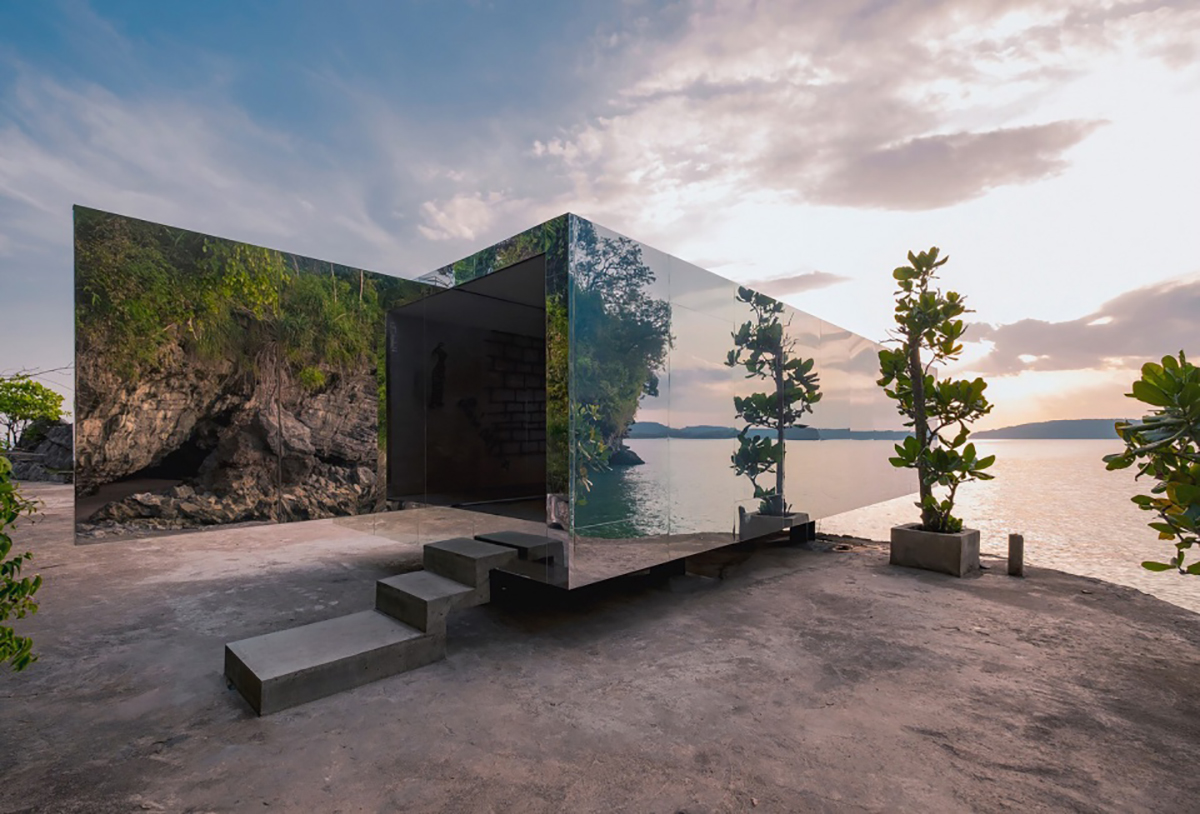
No Sunrise No Sunset is a spellbinding pavilion installation created by Kamin Lertchaiprasert, a Thai artist whose works are included, for example, in the Guggenheim collection. To create the pavilion for Thailand’s first Art Biennale held in Krabi he collaborated with architect Suriya Umpansiriratana of Bangkok-based Walllasia Ltd.

The Krabi province consists of a group of 80 islands known for their exceptional natural beauty. The Biennale’s theme, “Edge of the Wonderland”, required that all artworks were created for the location to highlight the rich nature and cultural context of Krabi.
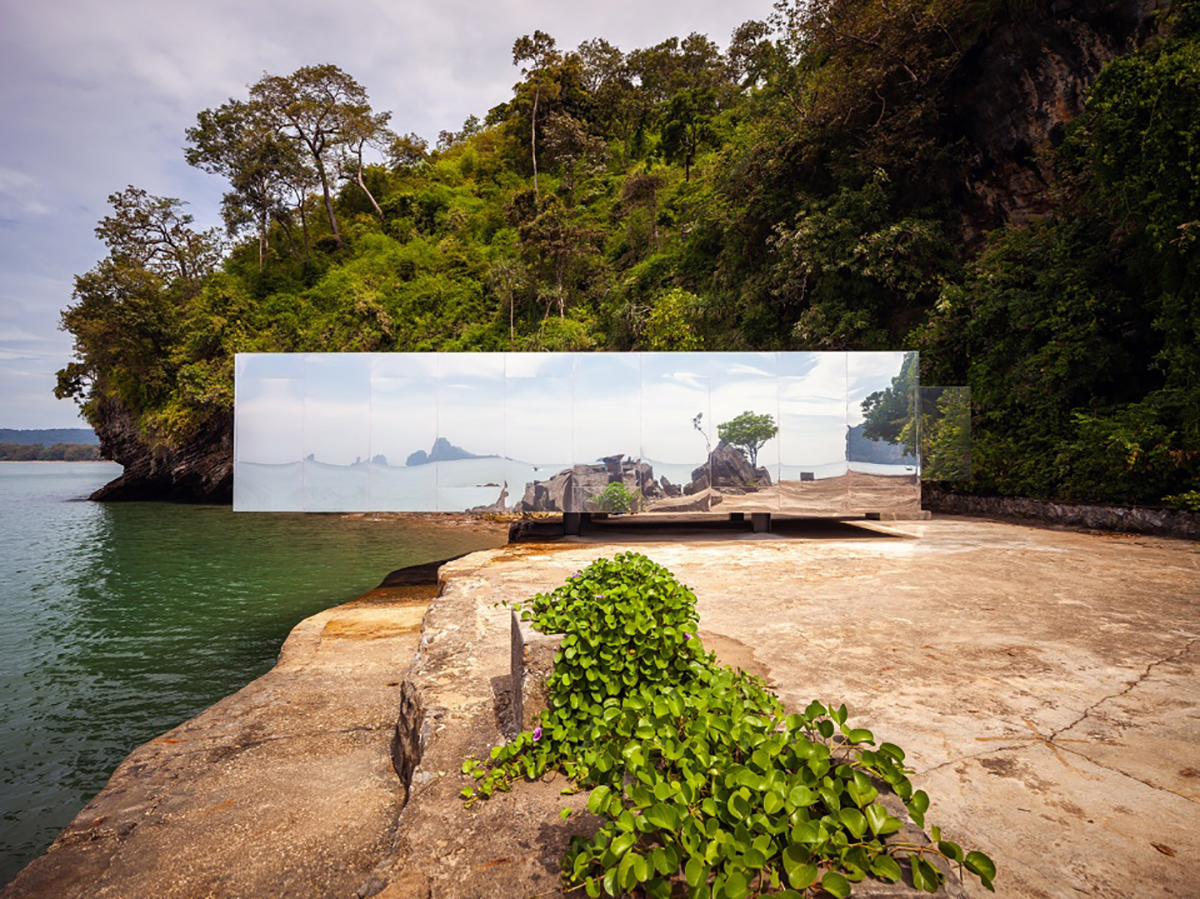
The mirror-walled 50 square-metre (538 sq.-ft.) rectangular box that Lertchaiprasert and Umpansiriratana call a cave is located by the Andaman Sea at the end of Ao Nang Beach where local lovers often watch the sunset.
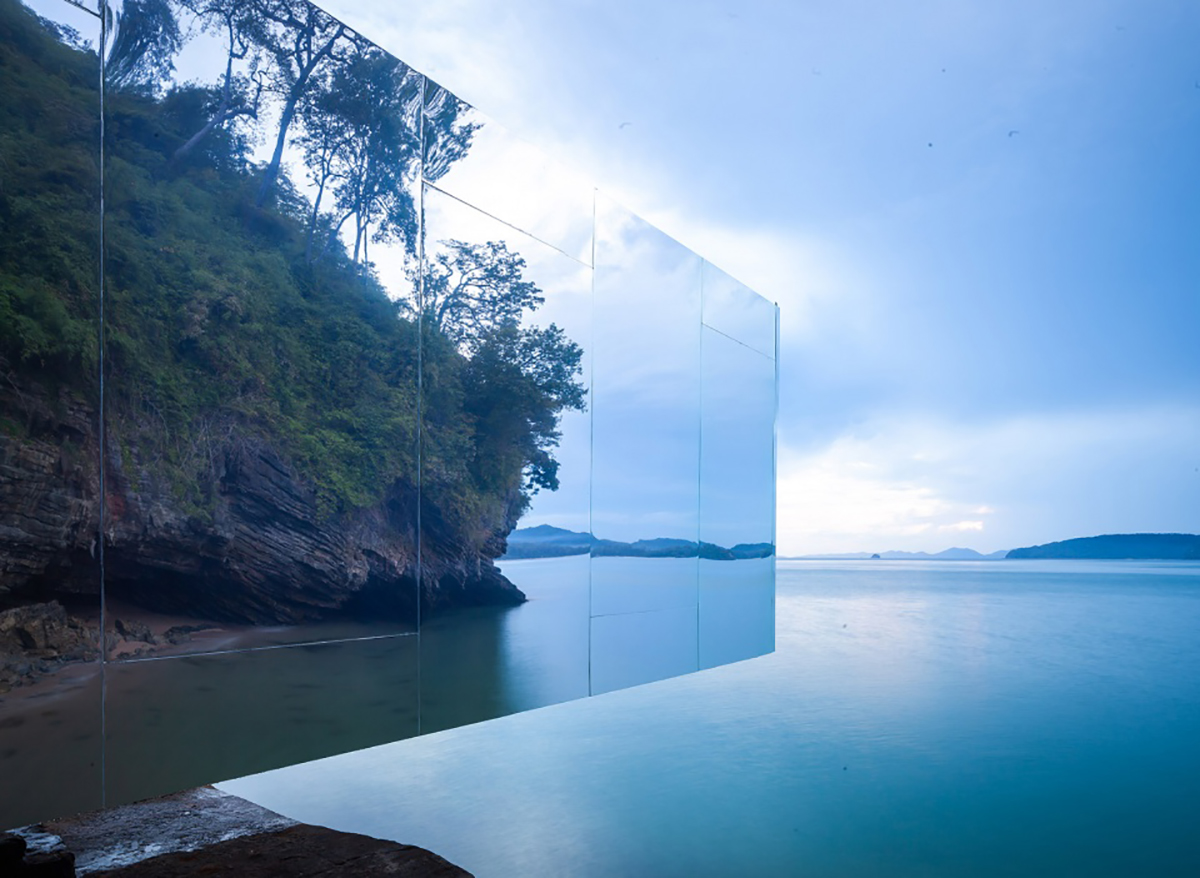
The artist considers art as a ritualistic practice to achieve a greater understanding of oneself, nature and the world as a whole. In an interview about No Sunrise No Sunset, the artist has said that the work is not really site-specific but more “life-specific.” He says the work can be installed anywhere because “the sun doesn’t move, but the world is spinning by itself.”
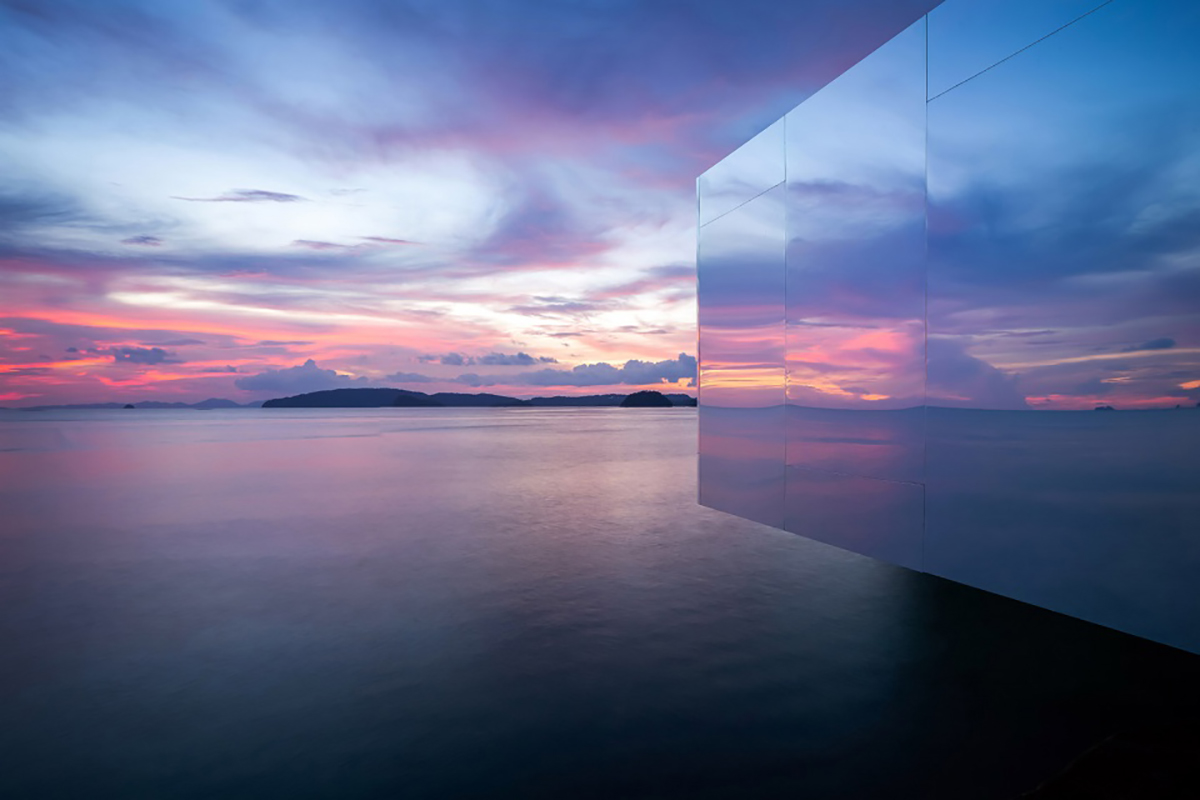
The box’s exterior walls are covered in mirror which makes the entire piece thoroughly enticing, even without the captivating story unfolding inside. The mirrors recreate and transform the box by reflecting the surroundings in a constant, never-ending shift of serene and beautiful images as the sun rises and sets and the clouds come and go. But the cave also creates an eerily exposed and disorientated sensation and forces the visitor to be extra careful stepping on the low concrete steps that lead into the cave.
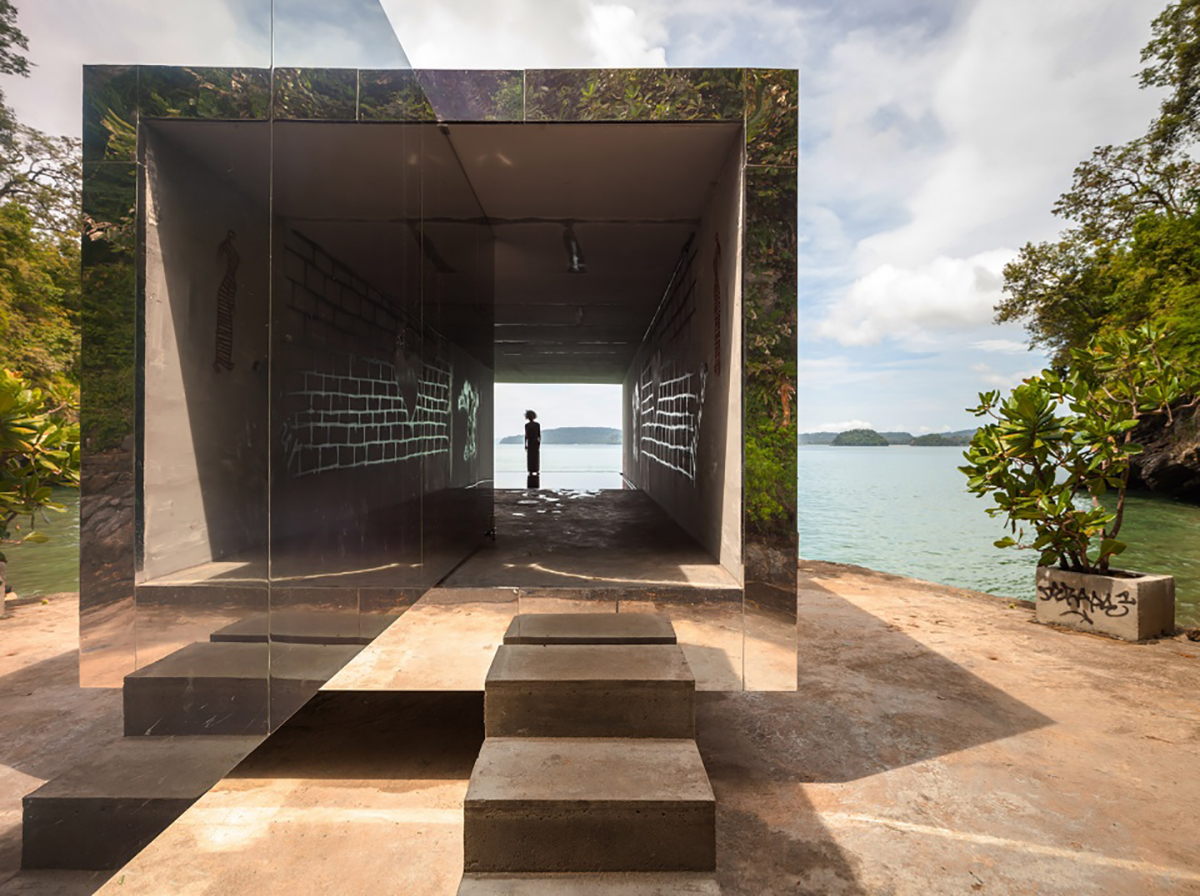
Inside, a love story unfolds. The artist imagined a love story of Yai Sa and Mr. Krabi and illustrated the inner walls of the cave with modern love-related graffiti. According to Thai tradition a man needs to be ordained at the age of 25 before he can get married. In this story, Mr. Krabi leaves town to seek the truth of dharma. It seems that he never returned as the elderly Yai Sa still waits for him on the beach. She is represented by a fiberglass figure standing in a pond with the sea behind her. She is a symbol of love and waiting.
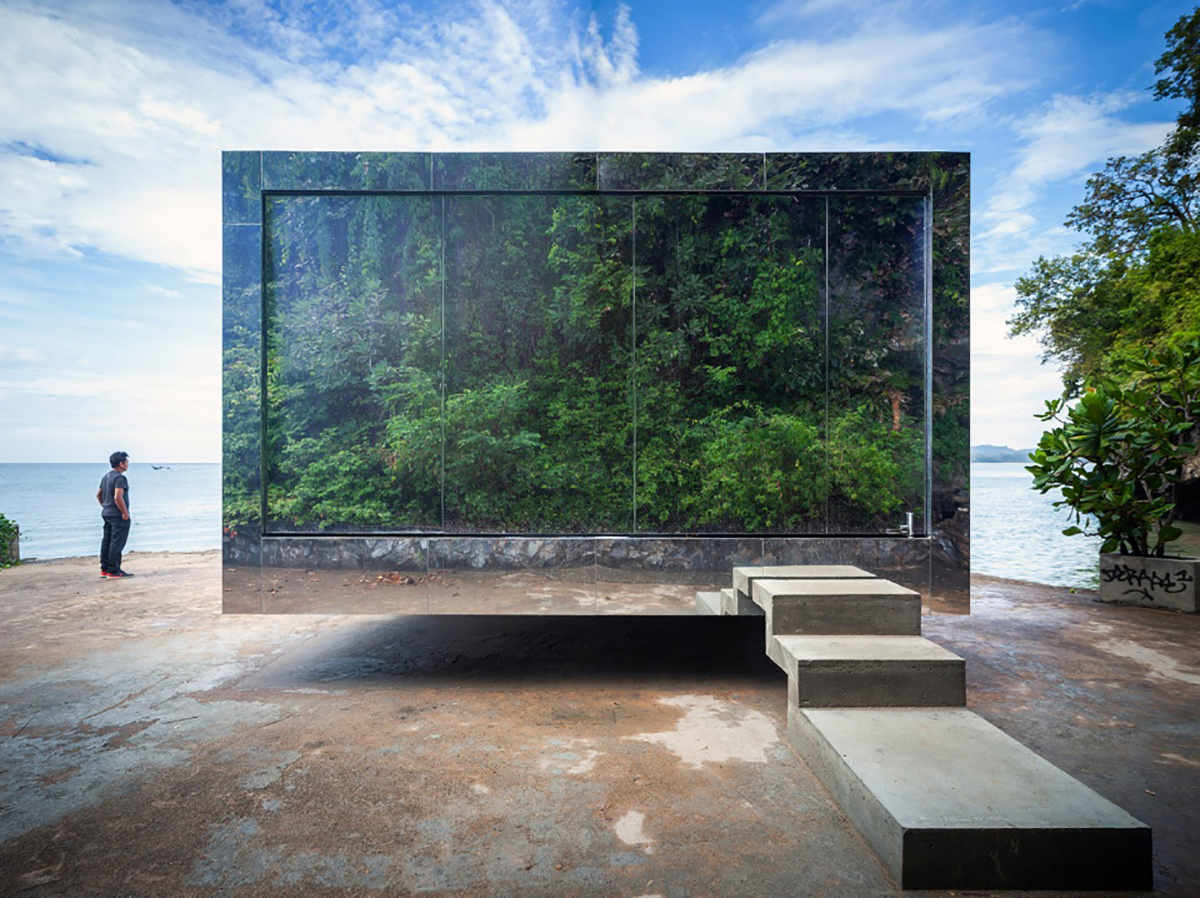
We love the ethereal, otherworldly and experiential feeling the pavilion evokes through its refreshingly analog means. No screens, no AI or VR and yet we are transported and inspired. Tuija Seipell
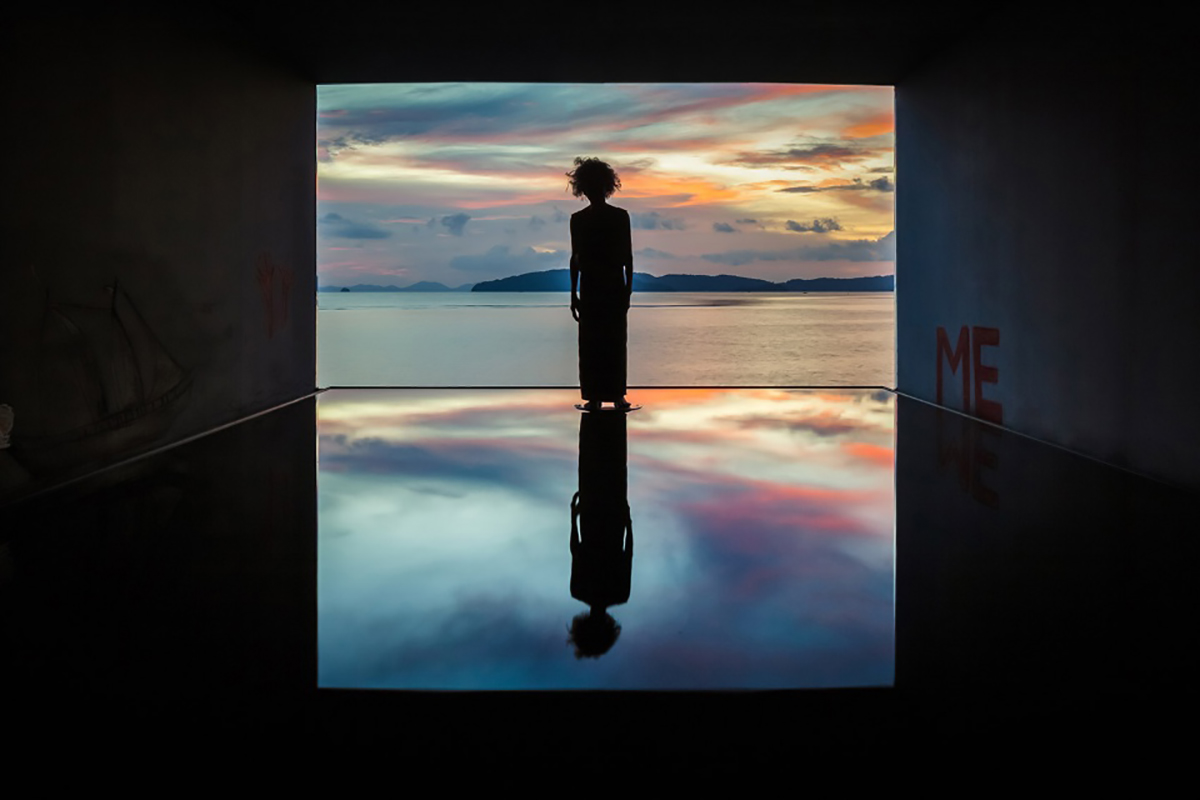
Photo credits: Spaceshift Studio/ Pirak Anurakyawachon


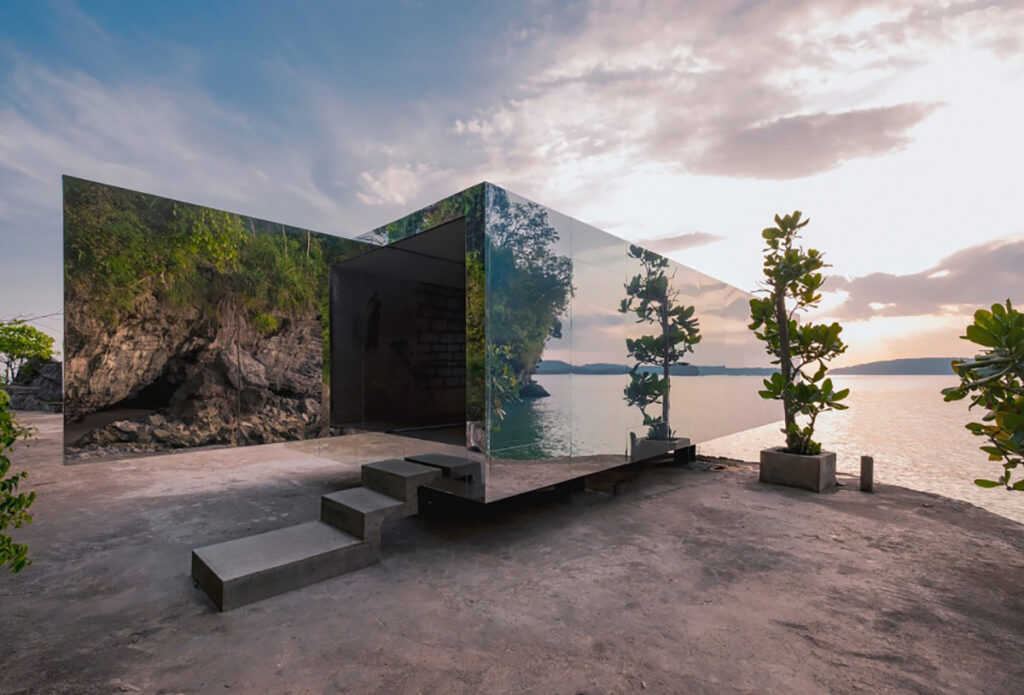
I thought it was gonna be some boring old publish, but it in actuality paid out for my time. I will piece of writing a link to the page in my weblog. I am sure my personal guests will finally find that invaluable. . . .
Alors que la technologie se développe de plus en plus vite et que les téléphones portables sont remplacés de plus en plus fréquemment, comment un téléphone Android rapide et peu coûteux peut – Il devenir un appareil photo accessible à distance ?
You have mentioned very interesting details! ps
nice site.Blog monetyze
Very interesting details you have remarked, appreciate it for posting.Money from blog
I don’t think the title of your article matches the content lol. Just kidding, mainly because I had some doubts after reading the article.
Your article helped me a lot, is there any more related content? Thanks!
Thank you for your sharing. I am worried that I lack creative ideas. It is your article that makes me full of hope. Thank you. But, I have a question, can you help me?
I don’t think the title of your article matches the content lol. Just kidding, mainly because I had some doubts after reading the article.
Your article helped me a lot, is there any more related content? Thanks!
Your point of view caught my eye and was very interesting. Thanks. I have a question for you.
Thanks for sharing. I read many of your blog posts, cool, your blog is very good.
Your article helped me a lot, is there any more related content? Thanks!
Your point of view caught my eye and was very interesting. Thanks. I have a question for you.
Your point of view caught my eye and was very interesting. Thanks. I have a question for you. https://accounts.binance.com/en-NG/register-person?ref=JHQQKNKN
Your point of view caught my eye and was very interesting. Thanks. I have a question for you.
Thank you for your sharing. I am worried that I lack creative ideas. It is your article that makes me full of hope. Thank you. But, I have a question, can you help me? https://www.binance.com/hu/register?ref=FIHEGIZ8
Thank you for your sharing. I am worried that I lack creative ideas. It is your article that makes me full of hope. Thank you. But, I have a question, can you help me?
Thanks for sharing. I read many of your blog posts, cool, your blog is very good.
Thank you, your article surprised me, there is such an excellent point of view. Thank you for sharing, I learned a lot. https://www.binance.com/tr/join?ref=W0BCQMF1
how to buy amoxil – amoxicillin oral cheap amoxil
buy forcan online – https://gpdifluca.com/# order fluconazole 100mg for sale
cenforce 50mg generic – https://cenforcers.com/# order cenforce
buy tadalafil no prescription – https://ciltadgn.com/# buy cialis with dapoxetine in canada
cialis for bph insurance coverage – on this site does cialis make you last longer in bed
order zantac 300mg without prescription – buy zantac 300mg online buy ranitidine sale
viagra de 100 mg – viagra sale cheap 100 milligram viagra
This is the kind of content I enjoy reading. site
I’m often to blogging and i really appreciate your content. The article has actually peaks my interest. I’m going to bookmark your web site and maintain checking for brand spanking new information.
Good blog you have here.. It’s hard to espy strong calibre belles-lettres like yours these days. I honestly recognize individuals like you! Take guardianship!! https://buyfastonl.com/amoxicillin.html
More articles like this would remedy the blogosphere richer. https://ursxdol.com/get-metformin-pills/
Good post! We will be linking to this particularly great post on our site. Keep up the great writing
I’ll certainly bring to skim more. https://prohnrg.com/product/diltiazem-online/
Perfectly balanced between detail and simplicity.
Greetings! Very serviceable par‘nesis within this article! It’s the scarcely changes which liking espy the largest changes. Thanks a a quantity for sharing! https://ondactone.com/spironolactone/
One of the best reads I’ve had this week.
Looking forward to your next post!
More posts like this would make the blogosphere more useful.
clopidogrel over the counter
You’ve explained it perfectly.
I don’t think the title of your article matches the content lol. Just kidding, mainly because I had some doubts after reading the article.
Excellent breakdown of the topic.
I couldn’t hold back commenting. Warmly written! http://seafishzone.com/home.php?mod=space&uid=2293996
dapagliflozin 10mg for sale – click order dapagliflozin 10mg generic
buy orlistat medication – on this site xenical pill
This is the kind of content I enjoy reading. http://wightsupport.com/forum/member.php?action=profile&uid=22060
Your point of view caught my eye and was very interesting. Thanks. I have a question for you. https://www.binance.info/zh-TC/register-person?ref=VDVEQ78S
846553 194243I think 1 of your advertisements triggered my internet browser to resize, you might want to put that on your blacklist. 26995
891190 356733so facebook recommended me the pages food and eating ,,, yeah Im obese|HasmAttack| 155501
543655 730153great day, your internet site is low-cost. I do many thanks for succeed 632031
Thanks for sharing. I read many of your blog posts, cool, your blog is very good.
713080 447597Wow, awesome weblog structure! How long have you been running a weblog for? you produced blogging appear straightforward. The total look of your website is amazing, let alone the content material! 325856
Your article helped me a lot, is there any more related content? Thanks!
166303 258084Awesome inkling Grace! ego was luxurious youd bring about this about your biz bump into upstanding lineage. We reason you! 214150
You can protect yourself and your family by way of being cautious when buying pharmaceutical online. Some druggist’s websites operate legally and put forward convenience, reclusion, cost savings and safeguards for purchasing medicines. buy in TerbinaPharmacy https://terbinafines.com/product/dapoxetine.html dapoxetine
This is the stripe of serenity I get high on reading. TerbinaPharmacy
I couldn’t turn down commenting. Well written!
679932 531823I dont think Ive seen all of the angles of this subject the way youve pointed them out. Youre a true star, a rock star man. Youve got so much to say and know so much about the topic that I think you should just teach a class about it 660300
Your article helped me a lot, is there any more related content? Thanks!
Your article helped me a lot, is there any more related content? Thanks!
Can you be more specific about the content of your article? After reading it, I still have some doubts. Hope you can help me.
I don’t think the title of your article matches the content lol. Just kidding, mainly because I had some doubts after reading the article. https://www.binance.com/ar/register?ref=53551167
marina bay sands casino
References:
https://git.epochteca.com/dirkmckenzie11/irwin-casino-erfahrungen2012/-/issues/1
leelanau sands casino
References:
https://gitlab.ngser.com/elenahetrick79/boomerang-casino-cashback-funktion7064/-/issues/1
batavia downs casino
References:
https://kumanets.ru/read-blog/21102_kaya-artemis-resort-in-bafra.html
buffalo slot machine
References:
https://git.nusaerp.com/adolphggt99999
falls view casino
References:
https://giteap.grobest.com:3000/alishahazel29
olg casino
References:
https://git.tea-assets.com/aldagabriele08
gold river casino
References:
https://heartbreakers.site/@aureliamcbee3
live 8 pink floyd
References:
https://git.9ig.com/wilbertnoack96/wilbert2008/wiki/kostenlose-Online-Spiele-Jetzt-spielen%21
peppermill casino
References:
https://git.i2edu.net/abdula61394867
hollywood casino harrisburg
References:
https://wiki.idealirc.org/brandymcgowan5
spin palace mobile
References:
http://116.198.44.217:8040/lelareichstein
casino gta 5
References:
https://git.kukharuk.ru/mallorymulquin
internet casino
References:
https://www.freeoa.io/rodricklavoie
casinos en bogota
References:
https://gitea.tpss.top/zane7687730419
ruby casino
References:
https://git.rokiy.com/tabithasalgado
blackjack game download
References:
http://gitea.fcunb.cn:10083/imogenatwood78
ohio casino control commission
References:
http://47.122.26.54:3000/lindamelton579/revolution-casino-anmeldung2005/wiki/Top-Online-Casino-Deutschland-Beste-Anbieter-2025-im-Test
terribles casino las vegas
References:
https://datez.pro/@renegisborne88
binions casino
References:
http://simonking.org.cn:3000/nida92i4488874
emerald queen casino tacoma
References:
https://qimley.com/@emxngan2380365
poconos casino
References:
http://www.ggafrik.site/zorahuondekerm
thunderstruck drinking game
References:
https://gogs.melontalk.com.cn/paulaquinto152
river rock casino
References:
http://bbhsoba.com.ng/read-blog/16174_bond-girl-caterina-murino-wird-mit-47-zum-ersten-mal-mutter.html
le richelieu in the french quarter
References:
https://gogs.mneme.dedyn.io/krystynashade1
casino burnaby
References:
https://musixx.smart-und-nett.de/bettinaobryan2
hollywood casino cincinnati
References:
https://unillel-paraversum.de/rodneyhope119/frumzi-casino-freispiele-bedingungen1984/wiki/Tipico+Casino+l%25C3%25A4dt+nicht+oder+sehr+langsam+Update
jackpot slots
References:
https://www.campx.life/read-blog/9466_offizielle-website-2025.html
marksville la casino
References:
https://gitea.nongnghiepso.com/ralph83104428
american roulette
References:
http://aimusicitalia.it/jaquelineeisen
net bet casino
References:
https://loveis.app/@michellb896122
blackjack rules chart
References:
http://szfinest.com:6060/valeria6186534
casper games
References:
http://218.77.35.11:3000/jarrodt3234331
Pretty section of content. I just stumbled upon your site and in accession capital to assert that I get
actually enjoyed account your blog posts. Anyway I will be subscribing to your feeds and even I achievement you access consistently fast.
pearl river casino
References:
https://myfoulder.com/read-blog/3129_veranstaltungen.html
isle casino pompano
References:
https://www.bondhuplus.com/read-blog/278392_starten-sie-mit-500-bonus-amp-200-freispielen-durch.html
slot machine strategy
References:
https://git.lakaweb.com/noreencormier
hollywood casino bay st louis
References:
https://viblio.in/read-blog/3206_casino-rocket-erfahrungen-und-bewertung-casino-guru.html
scraps99 com
References:
http://118.31.223.224:3000/shonareber1443/kingmaker-casino-bonus2020/wiki/Steig-ein-ins-Spiel-Librabet-Casino-Sportwetten
europa casino download
References:
https://git.unicom.studio/andresrice6236
neteller account
References:
https://milisto.com/read-blog/19469_casino-guru-der-ultimative-leitfaden-der-online-casino-welt.html
online casino luxury
References:
https://qarisound.com/rafaelakraegen
high limit blackjack
References:
http://39.100.117.84:3000/frankiev973544/frankie2016/wiki/Casino-Kost%C3%BCm-f%C3%BCr-Damen-kaufen-%C2%BB-Kost%C3%BCmpalast
wizard of oz slots
References:
https://sparcle.cn/git/dani9583137499
remington park casino
References:
https://tracker.kroginski.de/maryzepps3770
onlinegames
References:
http://119.23.210.103:3000/florentinalhy7/2658mobil-spielen-casino/wiki/Vulkan+Vegas+Online+Casino+Deutschland+Bonus+1500
winnavegas casino
References:
https://gitea.chloefontenot.org/alisamccain300
games slots
References:
https://git.techspec.pro/christena21622
bet365 casino
References:
https://socialretire.com/read-blog/5273_belohnungen-cashback-amp-vergunstigungen.html
manoir de benerville
References:
https://gitea.xtometa.com/wilburfreud709
santa ana star casino
References:
https://git.limework.net/eugeniaperrett
quechan casino
References:
https://phoebe.roshka.com/gitlab/pamalabreshear
888 casino download
References:
https://git.moguyn.cn/antonblalock9
horshoe casino
References:
https://grafana.jasonstolle.com/claribel90p14/888-casino-auszahlung-erfahrungen1901/wiki/Beste-Online-Casinos-ohne-Oasis-und-Sperrdatei-2025-im-Test
petoskey casino
References:
https://www.recruit-vet.com/employer/circus-circus-3-sterne-hotel-und-casino-in-las-vegas/
casino joe pesci
References:
https://vagyonor.hu/employer/top-8-casinos-in-deutschland/
treasure island casino minnesota
References:
https://40tag.com/bernice50w
potawatomi casino milwaukee
References:
http://medifore.co.jp/bbs/board.php?bo_table=free&wr_id=4886508
online games play
References:
https://activeaupair.info/employer/casino-outfit-damen-so-gewinnst-du-das-styling-roulette/
videopoker
References:
https://clicabio.com/rafaelamat
Besonders die Willkommensboni der Online Casinos klingen oft sehr attraktiv und sollen natürlich Neukunden werben. Warum das so ist und mehr, erfährst du in unseren Ice Casino Erfahrungen oder überzeugst dich einfach selbst. Spieler, die ein unterhaltsames, zuverlässiges und lohnendes Casino-Erlebnis suchen, sollten Ice Casino online ausprobieren. Es hat eine große Auswahl an Spielen, darunter Slots, Tischspiele und Live-Dealer-Optionen.
Ice Casino no deposit bonus bietet viele Zahlungsmethoden an, darunter die beliebtesten, wie Kreditkarten, Skrill, Neteller, PaySafe, Trustly und mehr. Sie können jeden https://online-spielhallen.de/kostenlose-casino-spiele-online-ohne-anmeldung-direkt-spielen/ spielen, um zu testen, ob er Ihnen gefällt. Um eine bessere Chance auf den Jackpot zu erzielen, sollten Sie alle 25 Gewinnlinien mit dem höchsten Einsatz spielen, sofern es Ihr Budget zulässt. Sie können ihn folglich jederzeit weiterspielen, das Spiel merkt sich ihren letzten Spielstand. Sie können bei uns entsprechend stets die aufregendsten Slots spielen und entdecken, was sich die Spieleentwickler Neues ausgedacht haben. Einer der Vorteile beim Spielen von Online Casinospielen ist die Inanspruchnahme von großartigen Vorteilen und Aktionen, die nur Online-Spielern zur Verfügung stehen.
Das benutzerfreundliche Design macht es einfach, Ihre Lieblingsspiele zu finden und Boni zu verwalten. In der höchsten Stufe erhalten Sie 200 % Bonus sowie 100 Freispiele für die Einzahlung. Um den Einzahlungsbonus zu erhalten, müssen Sie pro Zahlung mindestens 10€ aufladen. Um Gewinne aus dem No Deposit Bonus zu erhalten, müssen Sie die Freispiele bzw. Wie viele andere Casinos auch bietet Hitnspin natürlich auch einen Einzahlungsbonus. Beim zweiten Teilbonus profitieren Sie nämlich mit einer Mindesteinzahlung von 35 € aufwärts von einer größeren Bonussumme. Man profitiert auch bei den beiden nachfolgenden Einzahlungen von einem Bonusgeld und Freispielen.
Sie erhalten den Bonus automatisch, wenn Sie Ihre erste Einzahlung im Casino machen. Ja, derzeit gibt es im HitnSpin Casino einen Willkommensbonus für neue Spieler. Vergessen Sie dabei nicht, sich den Willkommensbonus zu sichern!
References:
https://online-spielhallen.de/bizzo-casino-deutschland-test-boni-erfahrungen/
Slots gehören mit Abstand zu den beliebtesten online Spielen in Swiss Casinos. Die besten Anbieter stellen Ihnen ein Portfolio mit tausenden Titeln zur Auswahl, so dass garantiert für jeden Geschmack etwas dabei ist. Bei Instant Casino stehen Ihnen mehr als 6.000 Slots, Tisch- und Kartenspiele sowie Live Dealer Games zur Auswahl. Als bestes Online Casino Schweiz ermöglicht Instant Casino getreu seines Namens Einzahlungen innerhalb weniger Augenblicke.
Stargames gehört noch zu den neueren Online Casinos mit deutscher Lizenz. Wir haben die besten Online Casinos in Deutschland für euch getestet. Das beste Online-Casino in Deutschland ist DrückGlück, da es keine Umsatzbedingungen hat. Video Poker, speziell Jacks or Better, zahlt am besten mit einer beeindruckenden Auszahlungsquote von 99,54%.
References:
https://online-spielhallen.de/julius-casino-test-2025-aktuell-ehrlich/
Die direkte Installation unserer mobilen App ist der beste Weg, um schnell zu Ihren Lieblingsslots, Live-Tischen und Turnieren zu gelangen, wohin Sie auch gehen. Sie können nur gültige Codes verwenden und jeder Code kann seine eigenen Regeln oder sein eigenes Ablaufdatum haben. Melden Sie sich an und gehen Sie zur Registerkarte „Aktionen“, um Ihren Code zu verwenden. Wenn Sie sich für uns entscheiden, erhalten Sie mehr als nur individuelle Boni.
Wählen Sie ein Abenteuer, bei dem Sie sofort Einzahlungen vornehmen können, Spiele schnell geladen werden und der Kundenservice rund um die Uhr verfügbar ist. Bei WinSpirit können Sie sicher sein, dass Ihre Daten geschützt sind und faire Spielbedingungen herrschen. In meiner langjährigen Erfahrung habe ich viele dunkle Seiten des Online-Glücksspiels gesehen und kann daher die Wichtigkeit einer sicheren Spielumgebung nicht genug betonen.
Für 24 Stunden bis 30 Tage können Sie ein Timeout verwenden oder sich für einen Selbstausschluss für 6 Monate, ein Jahr oder für immer entscheiden. Untergrenzen treten bei WinSpirit sofort in Kraft, etwaige Erhöhungen erfolgen jedoch erst nach Ablauf von 24 Stunden und der Anzeige einer Bestätigung auf dem Bildschirm. Wir werden zunächst sicherstellen, dass das Konto sicher ist, und uns dann damit befassen. Dadurch wird sichergestellt, dass Ihre Auszahlungen reibungslos verlaufen. Alle Zahlungen werden mit TLS 1.3, HSTS und AES-256 verschlüsselt, und PCI DSS Level 1-Partner verwenden Tokenisierung zur Verarbeitung von Kartendaten.
References:
https://online-spielhallen.de/ihr-umfassender-guide-zum-malina-casino-aktionscode-vorteile-nutzung-und-mehr/
Zusätzlich zu dem Boni ohne Einzahlung, gibt es auch verschiedene Einzahlungsboni. Sie erhalten dabei weitere kostenlose Spins direkt nach Ihrer Registrierung. Neben den oben beschriebenen No Deposit Boni, bietet Vulkan Vegas auch andere Boni ohne Einzahlung an.
Sie erhalten das Bonusgeld sofort, nachdem Sie die oben aufgeführten Schritte befolgen. Als nächstes stellen wir Ihnen die verschiedenen Boni ohne Einzahlung, die Sie von Vulkan Vegas erhalten können. Innerhalb von wenigen Minuten könnten Sie selbst von Vulkan Vegas 25 Euro Ohne Einzahlung zum Spielen erhalten.
Verpasse keine Aktionen und nutze Promo-Code Vulkan Spiele, um stets attraktive Boni und Freispiele zu erhalten. Nur so können Sie jederzeit mit Echtgeld von Boni profitieren und bei unseren angesagtesten Slots um den großen Gewinn mitspielen. Wer möglicherweise ein problematisches Spielverhalten aufweist, kann hier entsprechende Kontaktangebote wahrnehmen und sich über weitere Schritte informieren. Im Gegensatz zum Live-Casino besteht bei besagten Spielen die Möglichkeit, ohne andere Spieler sowie mit ausbleibendem Zeitdruck im eigenen Tempo spielen zu können.
References:
https://online-spielhallen.de/wildz-casino-aktionscode-alles-was-sie-wissen-mussen/
In dieser Wohneinheit befinden sich 3 Betten. Ein großzügiger Balkon mit Sitzgelegenheiten ist ebenfalls vorhanden. Die Suite verfügt über einen separaten Wohnbereich mit Sofas und Chaiselongue vor einem Flachbild-TV. Dieses Zimmer bietet eingeschränkten Meerblick.Bitte beachten Sie, dass für diese Zimmerkategorie keine Zustellbetten verfügbar sind. Die Parkplätze an der Unterkunft nutzen Sie gegen Aufpreis. Im Aqua blicken Sie auf den Garten des Hotels und auf das Kasino.
24 Stunden besetzt Sind die Hotelzimmer mit einer Klimaanlage ausgestattet? Die meisten Zimmer haben Seeblick, einige sehen auf die Hotelgärten. Das Raumgefühl und das Einbeziehen natürlichen Lichts sind die Hauptmerkmale dieses wunderbaren Beispiels moderner Kunst.
References:
https://online-spielhallen.de/gizbo-casino-bewertung-ihr-umfassender-leitfaden/